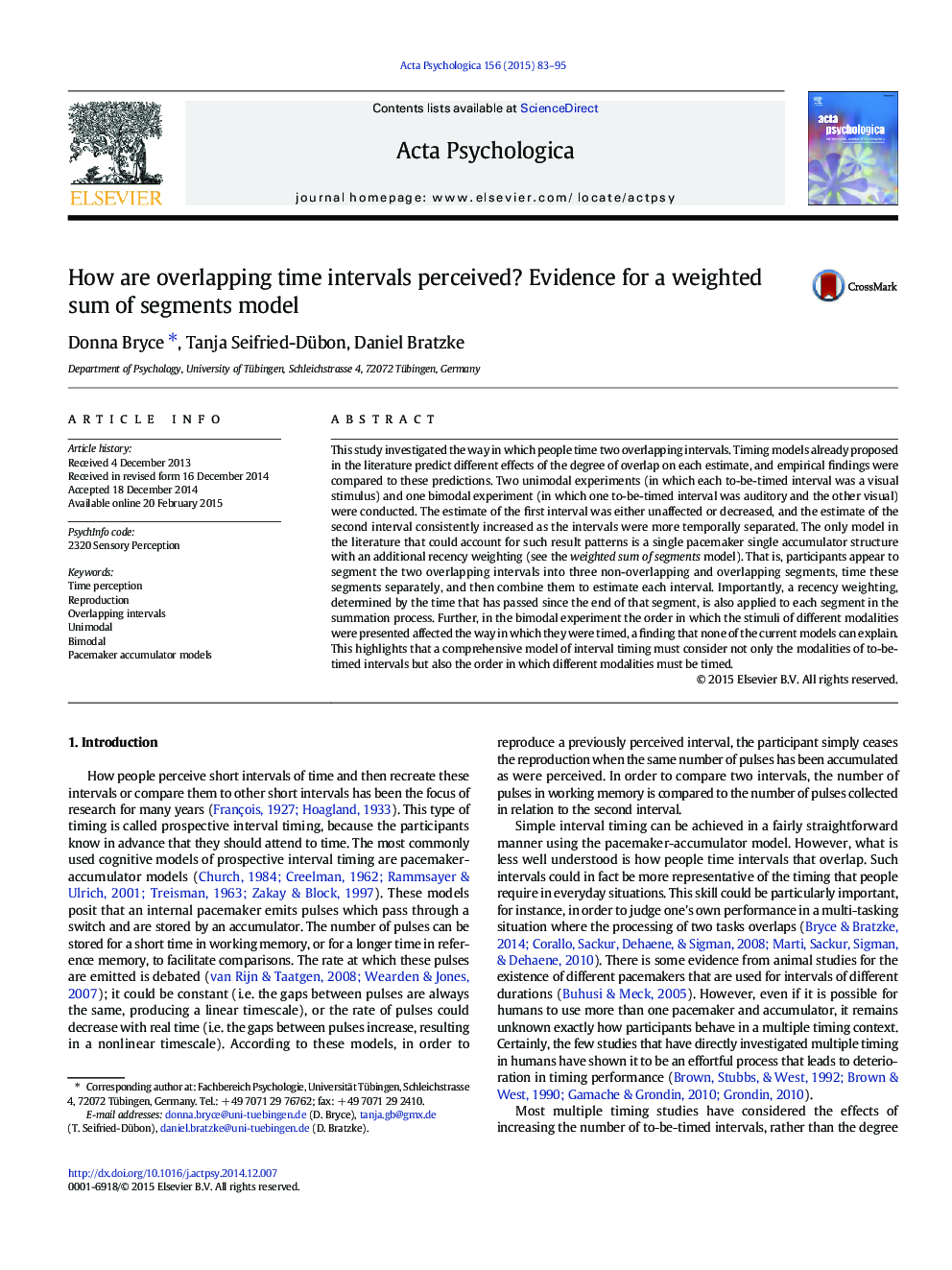| کد مقاله | کد نشریه | سال انتشار | مقاله انگلیسی | نسخه تمام متن |
|---|---|---|---|---|
| 7277459 | 1473602 | 2015 | 13 صفحه PDF | دانلود رایگان |
عنوان انگلیسی مقاله ISI
How are overlapping time intervals perceived? Evidence for a weighted sum of segments model
ترجمه فارسی عنوان
فواصل زمانی همپوشانی چگونه درک می شوند؟ شواهد برای مجموع وزن مدل
دانلود مقاله + سفارش ترجمه
دانلود مقاله ISI انگلیسی
رایگان برای ایرانیان
کلمات کلیدی
ترجمه چکیده
این مطالعه به بررسی نحوه برخورد دو فرد با فواصل همپوشانی پرداخت. مدلهای زمانبندی که در ادبیات پیشنهادی ارائه شده است، اثرات متفاوتی از میزان همپوشانی در هر برآورد را پیش بینی می کنند و یافته های تجربی با این پیش بینی ها مقایسه شده است. دو آزمایش غیرمعمول (که در آن هر فاصله زمانی بهنگام یک محرک بصری بود) و یک آزمایش دوبعدی (که در آن یک فاصله زمانی به موقع شنوایی و دیگری بصری) انجام شد. برآورد اولین فاصله یا بدون تأثیر یا کاهش یافت، و برآورد فاصله دوم، به طور فزاینده ای به طور فزاینده ای افزایش می یابد. تنها مدل در ادبیات که می تواند برای چنین الگوهایی نتیجه گیرنده باشد، یک ساختار تک باتری با یک ضربان ساز مجزا با وزن اضافی اضافی است (نگاه کنید به مجموع وزن بندی مدل های بخش). به این ترتیب، شرکت کنندگان به نظر می رسد دو فواصل همپوشانی را به سه بخش بدون هم پوشانی و همپوشانی تقسیم می کنند، زمانی که این بخش ها به طور جداگانه، و سپس آنها را برای برآورد هر فاصله بسازید. مهمتر از همه، وزن وزنی که تعیین شده توسط زمان که از پایان این بخش گذشت، نیز برای هر بخش در روند جمع شدن اعمال می شود. علاوه بر این، در آزمایش دوطرفه، نظم که محرک های حالت های مختلف ارائه شده، تأثیری بر نحوه زمانبندی آنها داشتند، نتیجه گیری که هیچ کدام از مدل های کنونی نمی تواند توضیح دهد. این نشان می دهد که یک مدل جامع از زمانبندی فاصله باید نه تنها از لحاظ فواصل زمانی که باید انجام شود، بلکه همچنین باید نظم را در نظر بگیرد که شرایط مختلف باید به موقع باشد.
موضوعات مرتبط
علوم زیستی و بیوفناوری
علم عصب شناسی
علوم اعصاب شناختی
چکیده انگلیسی
This study investigated the way in which people time two overlapping intervals. Timing models already proposed in the literature predict different effects of the degree of overlap on each estimate, and empirical findings were compared to these predictions. Two unimodal experiments (in which each to-be-timed interval was a visual stimulus) and one bimodal experiment (in which one to-be-timed interval was auditory and the other visual) were conducted. The estimate of the first interval was either unaffected or decreased, and the estimate of the second interval consistently increased as the intervals were more temporally separated. The only model in the literature that could account for such result patterns is a single pacemaker single accumulator structure with an additional recency weighting (see the weighted sum of segments model). That is, participants appear to segment the two overlapping intervals into three non-overlapping and overlapping segments, time these segments separately, and then combine them to estimate each interval. Importantly, a recency weighting, determined by the time that has passed since the end of that segment, is also applied to each segment in the summation process. Further, in the bimodal experiment the order in which the stimuli of different modalities were presented affected the way in which they were timed, a finding that none of the current models can explain. This highlights that a comprehensive model of interval timing must consider not only the modalities of to-be-timed intervals but also the order in which different modalities must be timed.
ناشر
Database: Elsevier - ScienceDirect (ساینس دایرکت)
Journal: Acta Psychologica - Volume 156, March 2015, Pages 83-95
Journal: Acta Psychologica - Volume 156, March 2015, Pages 83-95
نویسندگان
Donna Bryce, Tanja Seifried-Dübon, Daniel Bratzke,
